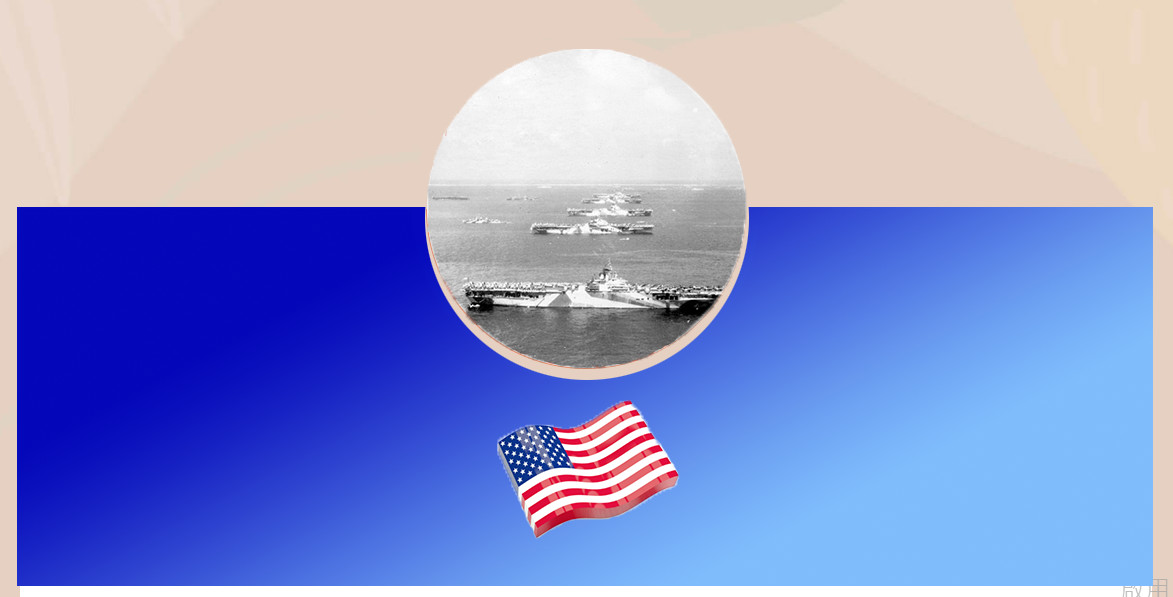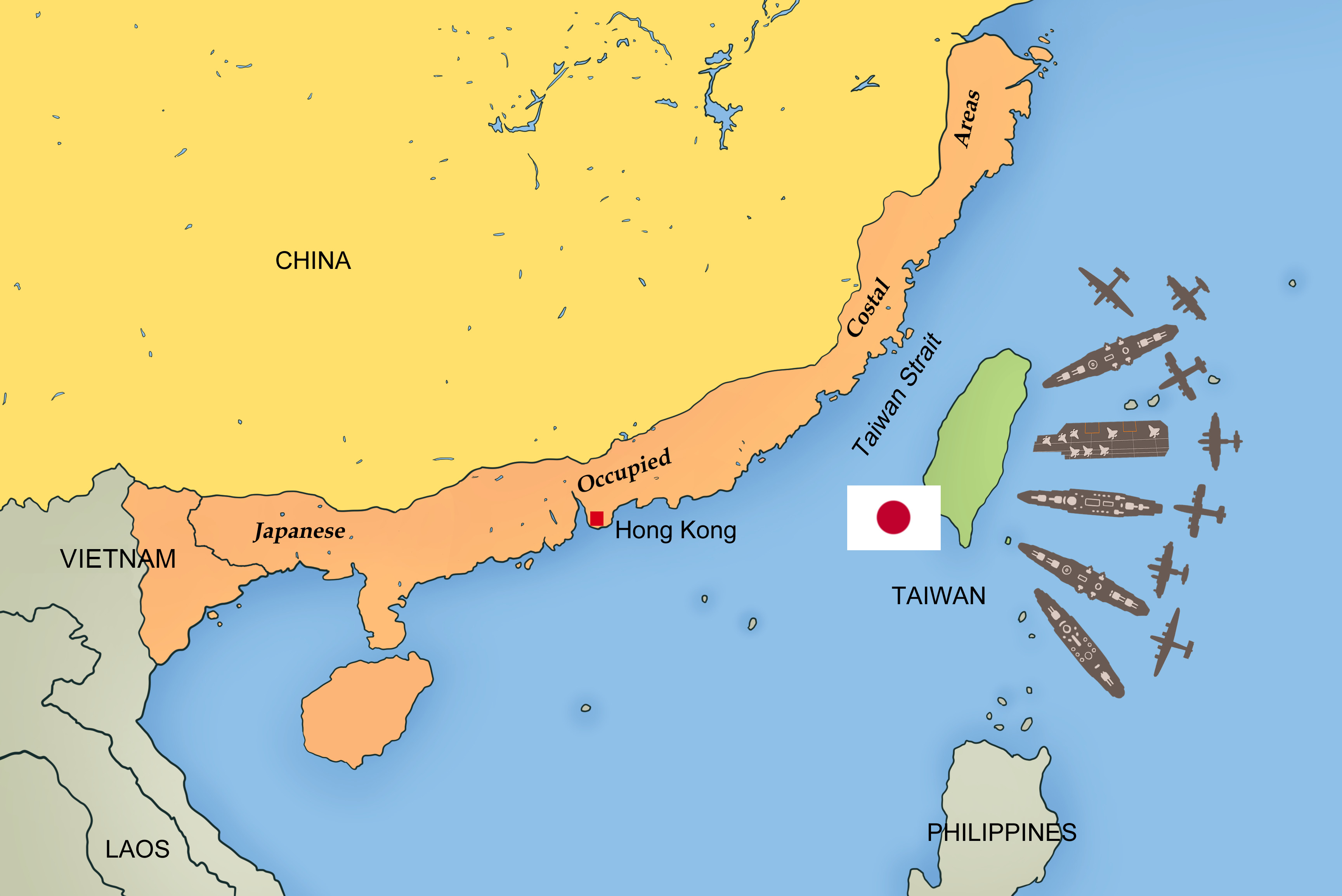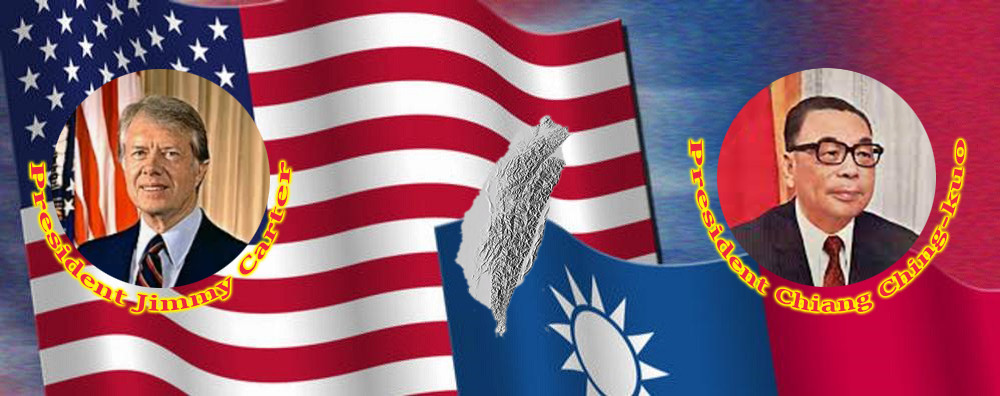Taiwan remains as "conquered territory of the United States."
Taiwan’s Fundamental Legal Position
The direct result of conquest is to obtain jurisdiction over the territory.
According to the wartime records assembled by US Dept. of War consultant George H. Kerr, and Brookings Institution Senior Fellow Richard C. Bush, US airplanes began bombing targets on Taiwan in November 1943. (FN: 1) (FN: 2) These US military attacks continued through early August 1945.
In the home islands of Japan, the early August 1945 US bombings of Hiroshima and Nagasaki finally convinced the Japanese Emperor to agree to an unconditional surrender.
| date | event |
|---|---|
| Sept. 2, 1945 | Sept. 2, 1945 Japanese surrender ceremonies held in Tokyo, aboard the USS Missouri |
| Sept. 2, 1945 | General Order #1 issued by General MacArthur in Tokyo |
| Sept. 5, 1945 | A US naval task force arrives off the northern Taiwan port of Keelung. (FN: 3) |

US Naval Task Force, Sept. 1945
Q: What was Taiwan’s legal position from mid-August through late-October 1945?
A: The legal status of Taiwan from mid-August 1945 through late-October 1945 was "conquered territory of the United States."
The territorial sovereignty of Taiwan was still held by Japan.
| date | event |
|---|---|
| mid-October 1945 | ROC military troops transported to Taiwan by US ships and aircraft |
| Oct. 25, 1945 | Japanese surrender ceremonies in Taipei |
THE MILITARY OCCUPATION OF TAIWAN BEGINS
Q: In relation to Taiwan, what happened in October 1945?
A: ROC military commanders and troops were transported by United States ships and aircraft to Taiwan.
After the holding of the surrender ceremonies on Oct. 25, the military occupation of Taiwan began. However,
Importantly, at this time, the territorial sovereignty of Taiwan was still held by Japan.
Operating under the superior command responsibility of the US Pacific Command and US Commander in Chief under the authority of General Order no. 1 (issued: Sept. 2, 1945) of the Supreme Commander for the Allied Powers, the ROC military commanders were exercising delegated administrative authority to undertake the military occupation.
The United States is the principal occupying power, and the ROC serves in the role of proxy occupying forces. Such an interpretation is confirmed by numerous Supreme Court rulings.
" . . . . . The right of one belligerent to occupy and govern the territory of the enemy while in its military possession is one of the incidents of war, and flows directly from the right to conquer."
-- US Supreme Court, Dooley v. U.S., 182 U.S. 222 (1901)
| date | event |
|---|---|
| circa Dec. 10, 1949 | ROC central government relocates to Taiwan |
In December 1949, the territorial sovereignty of Taiwan was still held by Japan. By moving to occupied Taiwan, the ROC has relocated itself outside of China’s national territory. This statement is strong proof that the ROC is now a government in exile. The ROC central government has moved to occupied Taiwan, however the ROC is not exercising sovereignty over this location.
Fundamentally speaking, during this time period, Taiwan remains as "conquered territory of the United States."
| date | event |
|---|---|
| April 28, 1952 | San Francisco Peace Treaty (SFPT) comes into force |
| August 5, 1952 | Treaty of Taipei comes into force |
In the SFPT, Japan renounced the territorial sovereignty of Taiwan, but no "receiving country" was specified. Under the SFPT,
United States Military Government (USMG) jurisdiction over the US conquered areas of Taiwan and the Ryukyu island group is confirmed in Article 4(b),
Clearly, Taiwan is territory taken from Japan incident to victory in the Pacific.
The United States of America is confirmed as "the principal occupying power" in Article 23.
During this time period, Taiwan remains as "conquered territory of the United States."
The Ryukyu island group is also fittingly described as "conquered territory of the United States."
TIMELINE
A more complete Timeline of related events is as follows:
Preface: (1) After the atomic bomb attacks on Hiroshima and Nagasaki, Japan, the Japanese Emperor agreed to an unconditional surrender. The formal Japanese surrender ceremonies were held on Sept. 2, 1945 in Tokyo.

General Douglas MacArthur, Sept. 2, 1945
(2) Sept. 2, 1945: General Douglas MacArthur issued General Order No. 1, directing "The senior Japanese commanders and all ground, sea, air and auxiliary forces within China (excluding Manchuria), Formosa and French Indo-China north of 16 north latitude shall surrender to Generalissimo Chiang Kai-shek."
(3) Oct. 25, 1945: Japanese surrender ceremonies in Taiwan were held. Although the surrender ceremonies were held on behalf of the Allies, the ensuing military occupation of Taiwan was conducted on behalf of the "conqueror" and the legal occupier, which is the United States of America. This date marks the beginning of the military occupation of Taiwan.
Neither of the above three actions/events resulted in a transfer of Taiwan’s territorial sovereignty.
Additional actions/events in following years can be analyzed as follows:
| Date | Event/Action | Has this resulted in a transfer of Taiwan’s territorial sovereignty? |
|---|---|---|
| Dec. 10, 1949 | The ROC moved its central government to occupied Taiwan | No |
| April 28, 1952 | The SFPT came into force | No (In the SFPT, Japan renounced its territorial sovereignty over Taiwan, but no receiving country was specified.) |
| Aug. 5, 1952 | The Treaty of Taipei came into force | No (Article 2 of the Treaty of Taipei confirmed the arrangements of Japan renouncing its sovereignty over Taiwan without the specification of a "receiving country.") |
| March 3, 1955 | The ROC - USA Mutual Defense Treaty enters into force | No |
| Oct. 25, 1971 | The United Nations General Assembly passes Resolution #2758. The ROC is expelled from the United Nations. | No (Resolution #2758 does not discuss the territorial sovereignty of Taiwan.) |
| Feb. 28, 1972 | PRC and USA promulgate "Shanghai Communique" | No |
| Dec. 31, 1978 | Dec. 31, 1978 USA and ROC break diplomatic relations | No |
| Jan. 1, 1979 | PRC and USA promulgate Second Communique | No |
| Jan. 1, 1979 | Taiwan Relations Act takes force | No |
| Jan. 1, 1980 | ROC - USA Mutual Defense Treaty is cancelled | No |
| Aug. 17, 1982 | PRC and USA promulgate Third Communique | No |
CONCLUSION
Fundamentally speaking, from the Fall of 1945 to the present, Taiwan’s legal position has remained as "conquered territory of the United States."
In the above Timeline, the only one of the events which has caused an upgrading of Taiwan’s legal position is the coming into force of the April 28, 1952, SFPT. Under the specifications of the SFPT, Taiwan now immediately ascends to the status of US overseas quasi-trusteeship.
See -- US Overseas "quasi-Trusteeships"
A summary of the most important principles which should be observed in occupied territory are given on a separate webpage.
See -- Most Important Principles governing the Law of Occupation
OBJECTIONS AND REBUTTALS
to the above analysis
Objection #1: Most pro-China scholars stress that the combined effect of China’s Declaration of War Against Japan on Dec. 9, 1941; the Cairo Declaration of Dec. 1, 1943; the Potsdam Proclamation of July 26, 1945; and the Japanese Surrender documents of Sept. 2, 1945 and Oct. 25, 1945, did result in a transfer of Taiwan’s territorial sovereignty to China effective Oct. 25, 1945.
Rebuttal #1: If indeed there was a transfer of Taiwan's territorial sovereignty effective Oct. 25, 1945, then this fact must be based on an existing principle of international law (of the post Napoleonic period). If this is based on an existing principle of international law, then there must be additional examples.
Where are these examples? Where are the other instances where the conclusion of surrender ceremonies resulted in the international community recognizing an immediate transfer of territorial sovereignty? Four or five examples would be adequate to prove the point.
However, after decades of research into the Taiwan question, and countless arguments with scores of pro-China scholars, no one has been able to step forth and offer even a single example of this.
The conclusion appears obvious. If no one can submit even one example, it should be clear that the pro-China supporters’ explanation of the effect of the Oct. 25, 1945 surrender ceremonies as being "Taiwan Retrocession Day" remains as an exercise in self-delusion.
Objection #2: In fact, General MacArthur’s General Order no. 1 of Sept. 1, 1945, already shows the clear intent to transfer Taiwan’s sovereignty to the Republic of China.
Rebuttal #2: In reading this General Order, three important points become apparent. (1) It authorized the surrender and disposition of Japanese forces, not Japanese territories; (2) It was a military directive, establishing procedures for demobilizing Japanese forces; (3) It was not meant to settle political questions, and indeed General MacArthur had no authority to "adjudicate" any territorial cession issues.
Objection #3: When Japan renounced the territorial sovereignty of Taiwan in the SFPT without specifying a "receiving country," under international law that would render Taiwan as terra nullius, and the ROC would have every right to annex it.
Rebuttal #3: When the SFPT came into force, the military occupation of Taiwan continued. Hence, Taiwan was not terra nullius, rather it remained as occupied territory. To put this another way, the military government jurisdiction of the principal occupying power had not yet ended. For more details, please study the Taiwan Flowchart on this twdefense.info/trust3/ website.
Objection #4: A close reading of the 1955 ROC - USA Mutual Defense Treaty (MDT) shows that Taiwan was already recognized as part of the ROC’s national territory.
Rebuttal #4: This is not true. In conjunction with the ratification of the MDT, a report issued Feb. 8, 1955, by the US Senate Committee on Foreign Relations specified: "It is the view of the committee that the coming into force of the present treaty will not modify or affect the existing legal status of Formosa and the Pescadores."
Objection #5: Isn’t the legal and political status of Taiwan often described as "undetermined" ? This does not seem to correspond with a recognition that Taiwan is conquered territory of the United States.
Rebuttal #5: Being recognized with the fundamental legal status of "conquered territory of the United States" is not a final legal/political status for Taiwan. Taiwan’s undetermined status means that it remains in interim status under the law of occupation. Taiwan is occupied territory of the US, but at the same time it is an insular area of the US. Taiwan is probably best described as a US overseas quasi-trusteeship.
See -- US Overseas "quasi-Trusteeships"
In the future, it is still very much possible that Taiwan can upgrade its status within the US insular law framework.
ADDENDUM #1:

HISTORICAL CHANGES OF SOVEREIGNTY
| Date | Conqueror | Taiwan was acquired via ______ |
Taiwan was held under the dominion of _______ |
Taiwan’s sovereignty was held by _________ |
|---|---|---|---|---|
| 1624 | Dutch | conquest | Dutch, 1624 to 1662 | Dutch, to 1662 |
| 1662 | Koxinga | conquest | Koxinga, 1662 to 1683 | Koxinga, to 1683 |
| 1683 | Qing Dynasty | conquest | Qing Dynasty, 1683 to 1895 | Qing Dynasty, 1683 to 1895 |
| 1895 | Japan | conquest | Japan, 1895 to 1945 | Japan, to April 28, 1952 |
| 1945 | USA | conquest | USA, 1945 to present | (undetermined) April 28, 1952 to present |
This chart is explained as follows:
In 1624 the Dutch invaded Taiwan and established administration over the island. (During this period, in 1626 the Spanish invaded northwest Taiwan established jurisdiction there until the Dutch forced them to abandon their settlement in 1642.)
In 1662 the Dutch were defeated by a Ming loyalist, Cheng Cheng-kung (Koxinga) who established government rule over Taiwan.
In 1683 Qing Dynasty military troops defeated Koxinga to seize control of the island, and in 1887 Taiwan was made a province of Qing China.
In 1895, Japan defeated Qing China in the First Sino-Japanese War, The fighting in this war was primarily confined to northeastern China, however in the post-war Treaty of Shimonoseki Japan ceded Formosa and the Pescadores to Japan in perpetuity and full sovereignty.
In the period of WWII (Dec. 1941 to the Fall of 1945) over 96% of military attacks against (Japanese) Taiwan were conducted by United States military forces. Japanese troops in Taiwan surrendered on October 25, 1945, thus marking the beginning of United States Military Government (USMG) jurisdiction over "Formosa and the Pescadores." In General Order no. 1, General MacArthur delegated the administration of the military occupation of Taiwan to the Chinese Nationalists. Under such an arrangement, the United States is the principal occupying power, and the Republic of China is serving in the role of proxy occupying forces. Examination of the post-war treaty specifications for Cuba (Spanish American War) and Taiwan (WWII in the Pacific) strongly suggests that Taiwan is in interim status under the law of occupation and (the territorial sovereignty of) Taiwan is being held in trust by the US military authorities.
Relevance to the Present Day: The law of nations recognizes that territory may be acquired based on conquest, however in the post-Napoleonic period the disposition of such territory must be done according to the laws of war. During the WWII period, the United States acquired Taiwan based on conquest, and no US President from Harry Truman to the present has announced the end of USMG jurisdiction over Taiwan. Hence, this USMG jurisdiction remains in force up to the present day. In other words, as "conquered territory" of the United States, Taiwan remains under the jurisdiction of the US military authorities.
ADDENDUM #2:
MILITARY OCCUPATION v. ANNEXATION
From the second half of the eighteenth century onwards, international law came to distinguish between the military occupation of a country and territorial acquisition by invasion and annexation, the difference between the two being originally expounded upon by Emerich de Vattel in his opus The Law of Nations (1758). The distinction then became clear and has been recognized among the principles of international law since the end of the Napoleonic wars (circa 1820).
Sir William Blackstone, in his treatise Commentaries on the Laws of England, originally published 1765 - 1769 by the Clarendon Press at Oxford, also gave emphasis to this legal formulation. All of the territories Blackstone lists as dominions are the sovereign territory of the Crown: colonies, acquisitions and conquests, and so on.
To apply Blackstone's reasoning to the United States, we need merely substitute "federal government" for "Crown," and the meaning becomes clear.

The US Constitution came into force in 1789, and contains Seven Articles. The Supreme Court interprets the Constitution and does judicial review of the constitutionality of legislative or executive acts.
Indeed, as early as 1828, US Supreme Court Chief Justice Marshall offered this penetrating analysis in the famous American Insurance Company case:
"The Constitution confers absolutely on the government of the Union the powers of making war and of making treaties; consequently, that government possesses the power of acquiring territory, either by conquest or by treaty."
And more explicitly, in the 1872 case of United States v. Huckabee, the Court speaking through Mr. Justice Clifford, said:
"Power to acquire territory either by conquest or treaty is vested by the Constitution in the United States. Conquered territory, however, is usually held as a mere military occupation until the fate of the nation from which it is conquered is determined . . . . . . . "
Notes Part A: (1) Some persons claim that the concepts discussed above are no longer valid in the 20th and 21st centuries. This is not true. In particular, Article 51 of the United Nations Charter recognizes the right of self-defense.
During the WWII period, US military actions against Japan's four main islands, Japan's overseas territories, and other areas under the control of Japanese military forces were a direct response to the Japanese unprovoked military attacks against US territories on December 7-8, 1941.
(2) The overall meaning and force of the word "acquire" as used in these early US Supreme Court decisions must be carefully understood. This is explained further below in the "Summary of Relevant Principles."
After the close of the Napoleonic period, invasion and annexation ceased to be recognized by international law and were no longer accepted as a means of territorial acquisition. The Convention respecting the Laws and Customs of War on Land (Hague IV, 1907) and its Annex (aka "Hague Regulations") contained explicit provisions concerning the protection of civilians and their property in occupied territories.
Notes Part B: (1) According to the decision in Dooley v. U.S., 182 U.S. 222 (1901), and other related Supreme Court decisions, after the Japanese surrender ceremonies in Taiwan, it must be understood that the United States is serving in the role of "the legal occupier" (aka "principal occupying power").
(2) In exercising delegated administrative authority for the military occupation of Taiwan, the ROC may be called the "subordinate occupying power," or (to use more common phraseology) "proxy occupying forces."
(3) The San Francisco Peace Treaty (SFPT) does not provide any legal basis for the Republic of China government structure to remain in Taiwan after April 1952. However, some knowledgeable observers have opined that since their arrival in Taiwan in October 1945, ROC government officials have been acting under the superior command responsibility of the US military authorities. Based on this, they then advance the theory that the ROC is serving as an agent for the United States in the continuing governance of Taiwan after April 1952.
According to the rules of agency, a principal is bound by the acts of an agent if the agent has authority. There are three types of authority:  express (including written),
express (including written),  implied, and
implied, and  apparent.
apparent.
(4) Clearly, Taiwan is territory taken from Japan as a result of the US-led victory in the Pacific Theater of WWII. Notably, the ROC did not participate in the military actions which liberated Taiwan from Japanese sovereignty.
of Relevant Principles
In the post-Napoleonic era, in regard to territory conquered by foreign military forces, the following recognitions and principles are applicable.

Territory may be acquired as a result of conquest by military forces, and the "conqueror" is the (principal) occupying power,

The administration and disposition of such territory must be conducted according to the laws of war, which include the laws of military occupation,

The territory is under military occupation, and military occupation does not transfer sovereignty,

Military occupation is conducted under military government,

Military government continues until legally supplanted by a recognized "civil government" for the area,

Military occupation is period of "interim (political) status."

If there is to be a transfer of territorial sovereignty (aka "territorial cession"), then the full specifications must be given in a formal peace treaty,

Therefore before any act of territorial cession in a peace treaty, the following actions are prohibited:

announcement of the annexation of, or intent to conduct an annexation of, the territory;

implementation of military conscription regulations over the local populace, or mobilization of local persons in an organization of a military or semi-military character;

institution of mass naturalization procedures, measures, or policies over the local populace.

US military attacks on (Japanese) Taiwan beginning November 1943
Over 96% of all military attacks against Taiwan during the WWII period were made by US military forces, so it is clear that as a result of the Pacific War the United States has acquired Taiwan based on conquest.
In other words, at the most fundamental level, Taiwan is "conquered territory of the United States."
Accordingly, it must be recognized that Taiwan is included under the geographic scope of the US Constitution’s "common defense clause" (Art. I, Sec. 8, cl. 1).
Notes Part C: (1) After the period of the United States western expansion ended (circa 1893), many citizens gradually forgot the details on how the complete geographic scope of the US Constitution’s "common defense" clause was determined.
(2) In earlier times the populace had commonly recognized that the defensive needs of territory newly conquered/liberated by US military troops were directly handled by the US military. In other words, "conquered territory" was always held to be within the geographic scope of the "common defense" clause.
(3) Such an interpretation is also entirely consistent with the US Supreme Court decisions given in American Insurance Company v. Canter, 26 U.S. 511 (1828) and United States, Lyon v. Huckabee, 83 U.S. 414 (1872), cited previously.
(4) It therefore follows that all arrangements for Taiwan’s "national defense" (personnel, administration, equipment, etc.) should be handled directly by the Pentagon.
(5) The huge amount of war resources invested by the United States in the Pacific Theater of World War II had the direct result of achieving the liberation of Taiwan from Japan. Accordingly, the United States is certainly a stakeholder in the future (final) disposition of Taiwan.
REFERENCE
Published Work: Chiang Ching-kuo's Complete Works (Vol. 1)
subject: Requests to Return Taiwan to the United States
date: June 18, 1949
quote: " . . . recently, the Taiwan status issue of and the rumors about a UN trusteeship have been rampant. My father (Chiang Kai-shek) has a firm proposition and position on this matter . . . . . Britain and the United States are worried that I (i.e. "our ROC government") will not be able to guard Taiwan . . . . . thus creating a gap in the defense line of the Pacific islands, and so they urgently requested me to return Taiwan to the United States for management . . . . ."
source: (Former President of the Republic of China) Chiang Ching-kuo's Complete Works,
(Vol. 1, page 446),
Diary entry of June 18, 1949.
REFERENCE
Office/Agency: Dept. of State
subject: US policies in relation to China
date: October 28, 1954
quote: " . . . In this connection it may be noted that Japan never ceded sovereignty over Formosa and the Pescadores to China. Japan renounced its own sovereignty but left the future title undefined. Thus the United States as principal victor of Japan has an unsatisfied interest in these former Japanese islands."
source: Foreign relations of the United States,
1952-1954. China and Japan, Volume XIV,
Part 1 (1952-1954), page 811
REFERENCE
Office/Agency: National Security Council
subject: An Issue Undecided
date: August 30, 2007
quote: "Taiwan, or the Republic of China, is not at this point a state in the international community. The position of the United States government is that the ROC -- Republic of China -- is an issue undecided, and it has been left undecided, as you know, for many, many years."
source: Statement by Senior Director for Asian Affairs,
National Security Council (NSC), Dennis Wilder

Beginning in 1979, the Taiwan Relations Act (TRA) stipulates that the United States should "provide" or "make available" military hardware to the Taiwan governing authorities. (The TRA does not use the terminology of "sell to" or anything similar.) For an entity like Taiwan, it would make sense for the United States to provide all necessary personnel and military hardware directly, and to establish US military bases throughout the island.
Here in the 21st century, Taiwan has not yet reached a final political/legal status. Importantly, however, any final disposition of Taiwan must be conducted according to the laws of war. In regard to the specific details involved in making such as disposition, there is much established precedent which can be referenced. In particular, examination of the comparative historical and legal data for the US conquered areas of Cuba (after the Spanish American War) and the Ryukyu island group (after WWII) can prove insightful. Please see the Cuba Flowchart and the Ryukyu Islands Flowchart on this website.
FOOTNOTES
Footnote #1
Footnote #2
Footnote #3

| LINKs |
| Additional Webpages of Interest |
| Most Important Principles -- Law of Occupation |
| US Overseas "quasi-Trusteeships" |
| Truth of Taiwan's Undetermined Status |
[Chinese version] https://www.twdefense.info/trust3/conqterrch.html


